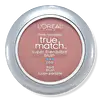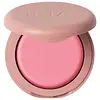What's inside
What's inside
 Key Ingredients
Key Ingredients

 Benefits
Benefits

No benefits
 Concerns
Concerns

 Ingredients Side-by-side
Ingredients Side-by-side

Talc
AbrasiveDimethicone
EmollientNylon-12
Polymethylsilsesquioxane
Cetyl Dimethicone
EmollientMagnesium Stearate
Cosmetic ColorantTrimethylsiloxysilicate
EmollientPhenoxyethanol
PreservativeMethylparaben
PreservativeSilica
AbrasiveEthylparaben
PreservativePropylparaben
PreservativeIsobutylparaben
AntimicrobialButylparaben
MaskingMica
Cosmetic ColorantCI 77891
Cosmetic ColorantCI 77491
Cosmetic ColorantCI 77492
Cosmetic ColorantCI 77499
Cosmetic ColorantCI 75470
Cosmetic ColorantCI 73360
Cosmetic ColorantCI 77007
Cosmetic ColorantMica
Cosmetic ColorantTapioca Starch
Synthetic Fluorphlogopite
Silica
AbrasiveCaprylic/Capric Triglyceride
MaskingSqualane
EmollientEthylhexyl Palmitate
EmollientGlycerin
HumectantEthylhexylglycerin
Skin ConditioningLauroyl Lysine
Skin Conditioning1,2-Hexanediol
Skin ConditioningGlyceryl Caprylate
EmollientDehydroacetic Acid
PreservativeBoron Nitride
AbsorbentXanthan Gum
EmulsifyingTin Oxide
AbrasiveLeontopodium Alpinum Callus Culture Extract
AntioxidantAlaria Esculenta Extract
Skin ProtectingTocopherol
AntioxidantCI 77163
Cosmetic ColorantCI 77891
Cosmetic ColorantCI 77491
Cosmetic ColorantCI 77492
Cosmetic ColorantCI 77499
Cosmetic ColorantCI 15850
Cosmetic ColorantCI 17200
Cosmetic ColorantCI 19140
Cosmetic ColorantCI 77007
Cosmetic ColorantCI 15985
Cosmetic ColorantCI 16035
Cosmetic ColorantCI 45410
Cosmetic ColorantMica, Tapioca Starch, Synthetic Fluorphlogopite, Silica, Caprylic/Capric Triglyceride, Squalane, Ethylhexyl Palmitate, Glycerin, Ethylhexylglycerin, Lauroyl Lysine, 1,2-Hexanediol, Glyceryl Caprylate, Dehydroacetic Acid, Boron Nitride, Xanthan Gum, Tin Oxide, Leontopodium Alpinum Callus Culture Extract, Alaria Esculenta Extract, Tocopherol, CI 77163, CI 77891, CI 77491, CI 77492, CI 77499, CI 15850, CI 17200, CI 19140, CI 77007, CI 15985, CI 16035, CI 45410
Ingredients Explained
These ingredients are found in both products.
Ingredients higher up in an ingredient list are typically present in a larger amount.
This pigment is called Ultramarine blue lazurite. It gives a saturated blue color, but can be used to create other colors as well.
According to the manufacturer, it is usually made from kaolin, sodium sulfate, sodium carbonate, sulfur, and charcoal.
Ci 77491 is also hydrated iron III oxide. It's sole purpose is to give a red/pink hue to products.
Iron III oxides are classified as inorganic chemicals for coloring.
Synthetically created Ci 77491 is considered safer than those naturally found. This is because the synthetically created version may contain less impurities. Iron oxides are generally non-toxic and non-allergenic.
Learn more about CI 77491Ci 77492 is also hydrated iron III oxide. It's sole purpose is to give a yellow hue to products.
Iron III oxides are classified as inorganic chemicals for coloring.
Synthetically created Ci 77492 is considered safer than those naturally found. This is because the synthetically created version may contain less impurities. Iron oxides are generally non-toxic and non-allergenic.
Learn more about CI 77492Ci 77499 is also hydrated iron III oxide. It is created from mixing red and black iron oxides. This helps give shades of darkness to a product.
Iron III oxides are classified as inorganic chemicals for coloring.
Ci 77891 is a white pigment from Titanium dioxide. It is naturally found in minerals such as rutile and ilmenite.
It's main function is to add a white color to cosmetics. It can also be mixed with other colors to create different shades.
Ci 77891 is commonly found in sunscreens due to its ability to block UV rays.
Learn more about CI 77891Mica is a naturally occurring mineral used to add shimmer and color in cosmetics. It can also help improve the texture of a product or give it an opaque, white/silver color.
Serecite is the name for very fine but ragged grains of mica.
This ingredient is often coated with metal oxides like titanium dioxide. Trace amounts of heavy metals may be found in mica, but these metals are not harmful in our personal products.
Mica has been used since prehistoric times throughout the world. Ancient Egyptian, Indian, Greek, Roman, Aztec, and Chinese civilizations have used mica.
Learn more about MicaSilica, also known as silicon dioxide, is a naturally occurring mineral. It is used as a fine, spherical, and porous powder in cosmetics.
Though it has exfoliant properties, the function of silica varies depending on the product.
The unique structure of silica enhances the spreadability and adds smoothness, making it a great texture enhancer.
It is also used as an active carrier, emulsifier, and mattifier due to its ability to absorb excess oil.
In some products, tiny microneedles called spicules are made from silica or hydrolyzed sponge. When you rub them in, they lightly polish away dead skin layers and enhance the penetration of active ingredients.
Learn more about Silica